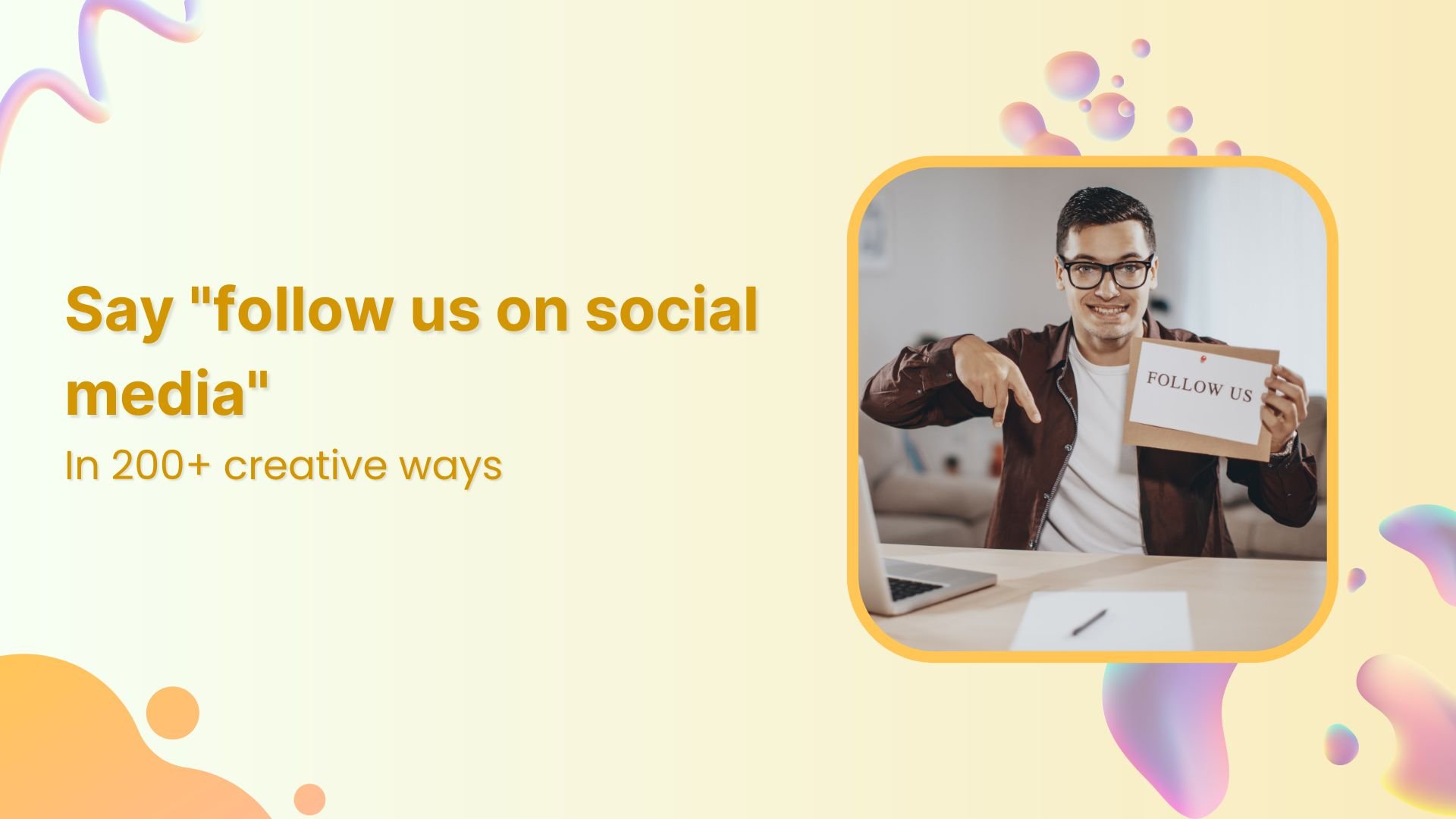Social media hooks: 30+ proven examples from top ceators (2025 guide)
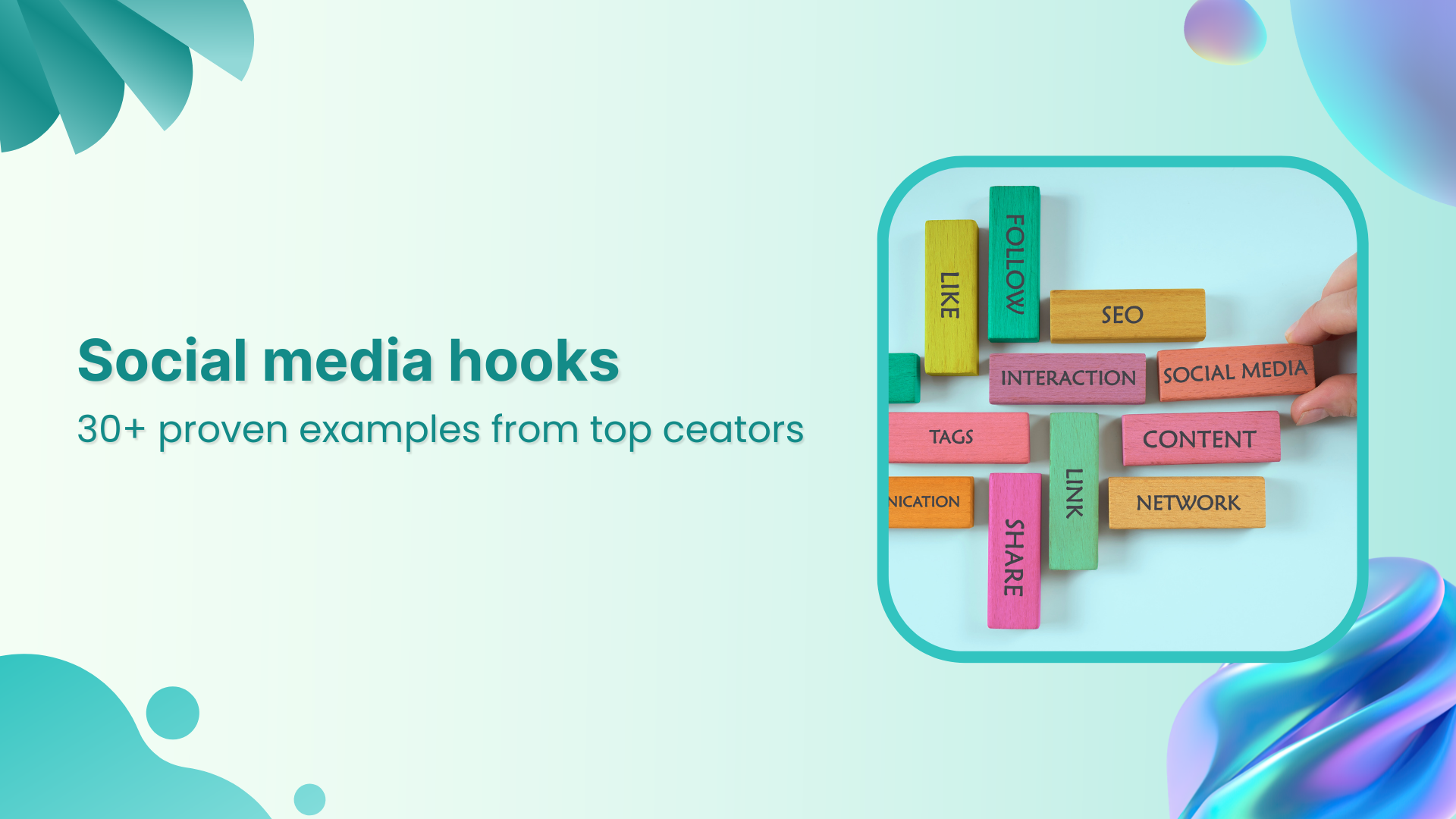
Ever wondered why some social media posts make you stop mid-scroll, while others barely register? The secret lies in mastering social media hooks—those crucial first few seconds determine if your content gets engaged or ignored. With attention spans dropping to just 1.7 seconds on mobile devices, crafting irresistible hooks has never been more critical for brands, creators, and marketers.
In this comprehensive guide, you’ll discover the psychology behind effective social media hooks, learn proven strategies used by top brands, and get access to 30+ hook examples that you can adapt for your content. If you struggle with low engagement or want to scale your social media success, this guide will change how you approach content creation.
The easiest way to manage and grow your social channels.
Try ContentStudio for FREE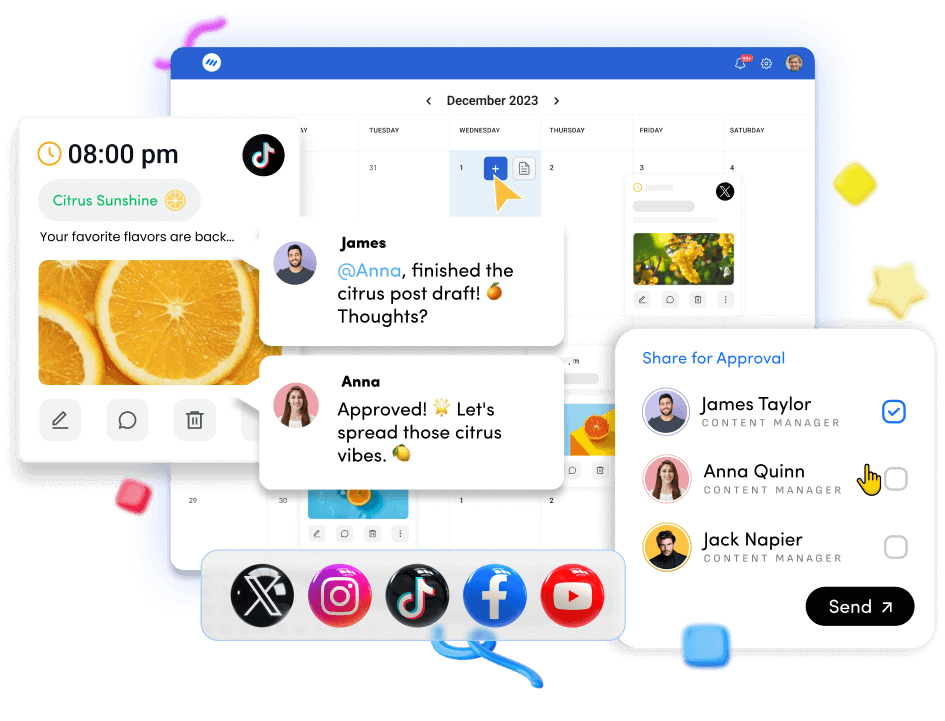
What is a social media hook?
A social media hook is a strategic opening element designed to instantly capture your audience’s attention within the first 1-3 seconds of viewing your content. Think of it as your content’s “first impression.” It could be a compelling opening line, an intriguing visual, a provocative question, or a bold statement that makes users stop scrolling and start engaging.
Example in Action: Instead of posting: “Check out our new skincare product,
Try this hook: “This $15 serum just outperformed products 5x more expensive—it’s the proof.”
The hook immediately creates curiosity (what serum?), provides social proof (outperformed expensive products), offers value (proof/results), and includes a specific price point that makes it accessible.
Social media hooks work across all platforms—from Instagram captions and TikTok opening lines to LinkedIn post starters and YouTube video intros. The key is understanding that hooks about social media performance have evolved significantly.
TikTok suggests that the first two seconds of a video are crucial for getting an audience’s attention. At the same time, Facebook reports that users have an attention span of fewer than two seconds for video content.
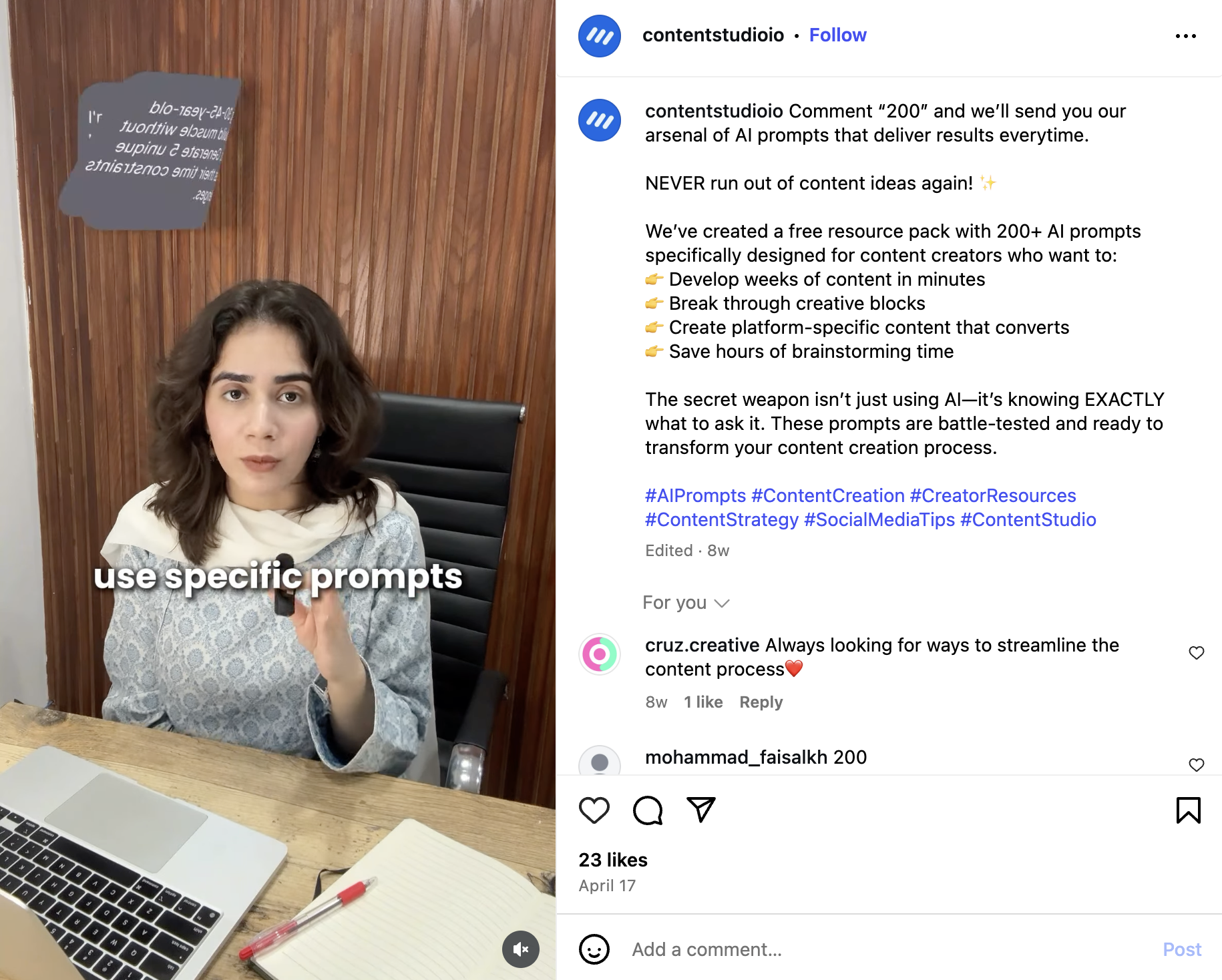
The six essential elements of scroll-stopping social media hooks
Crafting a compelling social media hook is more art than science, but certain elements consistently contribute to making them effective. Here are some critical factors that can help you create hooks that grab attention and drive engagement.
1. Immediate value proposition
Your hook must instantly communicate what’s in it for the viewer. A social media hook evokes curiosity, sparks interest, and prompts immediate action. The most effective hooks promise a clear benefit upfront.
Real-life examples:
@thehouseof.social uses powerful value-driven hooks like “50 content hooks that always stop the scroll,” immediately promising a specific number of actionable tools (50 hooks) with a clear benefit (stopping the scroll).
Strong value-based hook templates:
- “Save 3 hours a week with this productivity hack…”
- “The free tool that doubled my Instagram engagement…”
- “How I cut my grocery bill by 40% without coupons…”
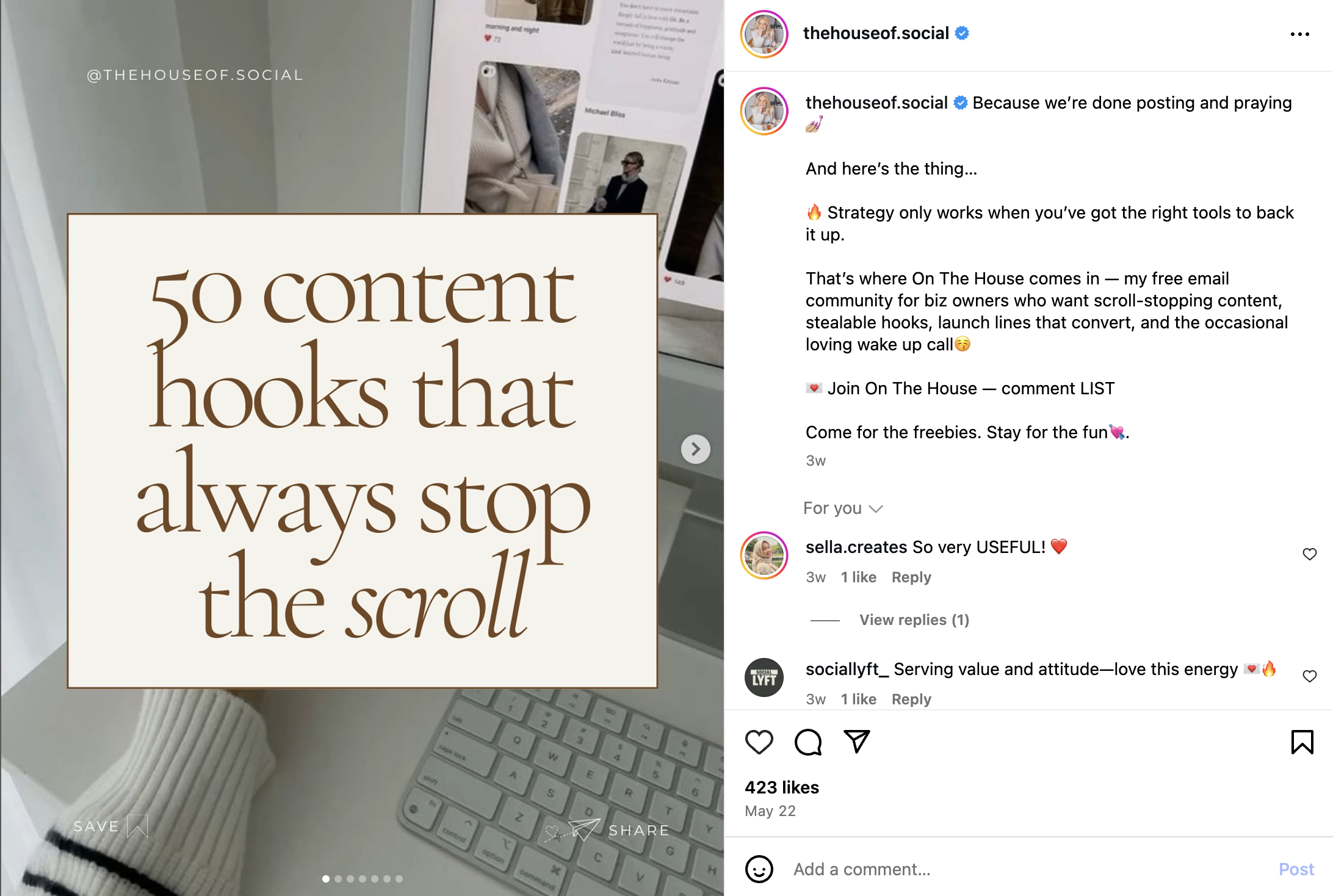
2. Emotional resonance
Hooks that tap into emotions—whether it’s joy, curiosity, nostalgia, or even a bit of fear—can make your content more memorable and shareable. Emotional triggers create psychological investment in your content.
Real-life examples:
@glowforyourskins uses curiosity-driven emotional hooks like “The REASON you need 4 skincare routines”—the word “REASON” in all caps creates intrigue. In comparison, the specific number (4 routines) makes viewers curious about why they need multiple routines. Her caption, “The only skin cycling you’ll ever need,” adds exclusivity, making followers feel they’re getting the ultimate solution.
Emotion-driven hook templates:
- Curiosity: “The skincare mistake 90% of people make…”
- Fear of Missing Out: “Everyone’s switching to this app except you…”
- Nostalgia: “Remember when we used to think this was healthy?”
- Surprise: “Plot twist: The cheapest option actually works best…”
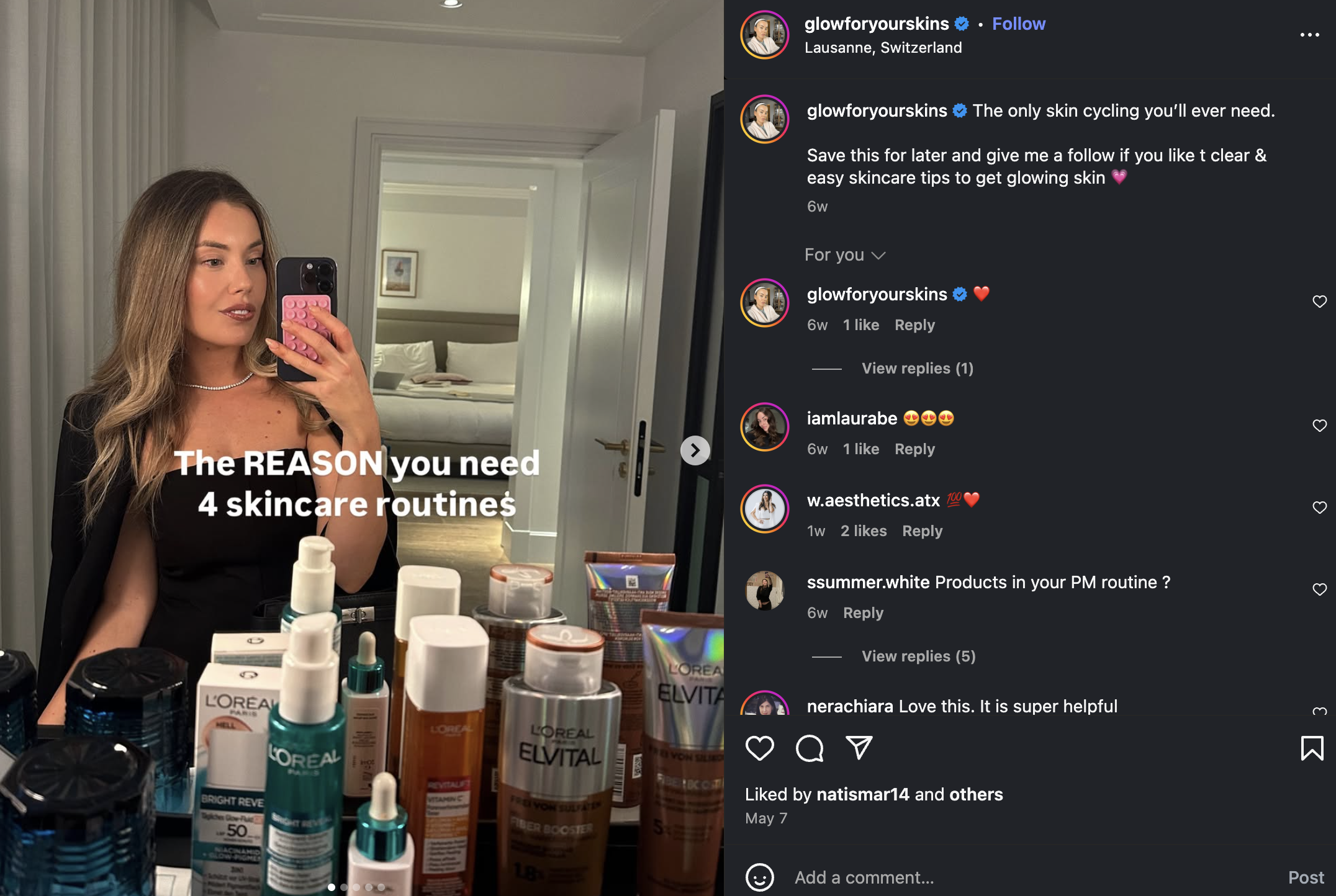
3. Specificity and Credibility
Vague hooks get ignored. Specific numbers, timeframes, and details make your content feel more credible and actionable.
Real-life examples:
@growwithcolby uses ultra-specific hooks like “7 things I know at 33 that I wish I knew at 23.” Combining act numbers (7 things) with precise ages (33 vs. 23) creates compelling specificity. This post generated more engagement because the specific age comparison makes it feel authentic and relatable, while “7” promises digestible, actionable insights.
Compare these hooks:
- ❌ Weak: “Great tips for better sleep”
- ✅ Strong: “3 sleep hacks that helped me fall asleep in under 5 minutes”
The specific version tells you exactly what you’ll learn (3 hacks), and the benefit (faster sleep) includes a precise timeframe (under 5 minutes).
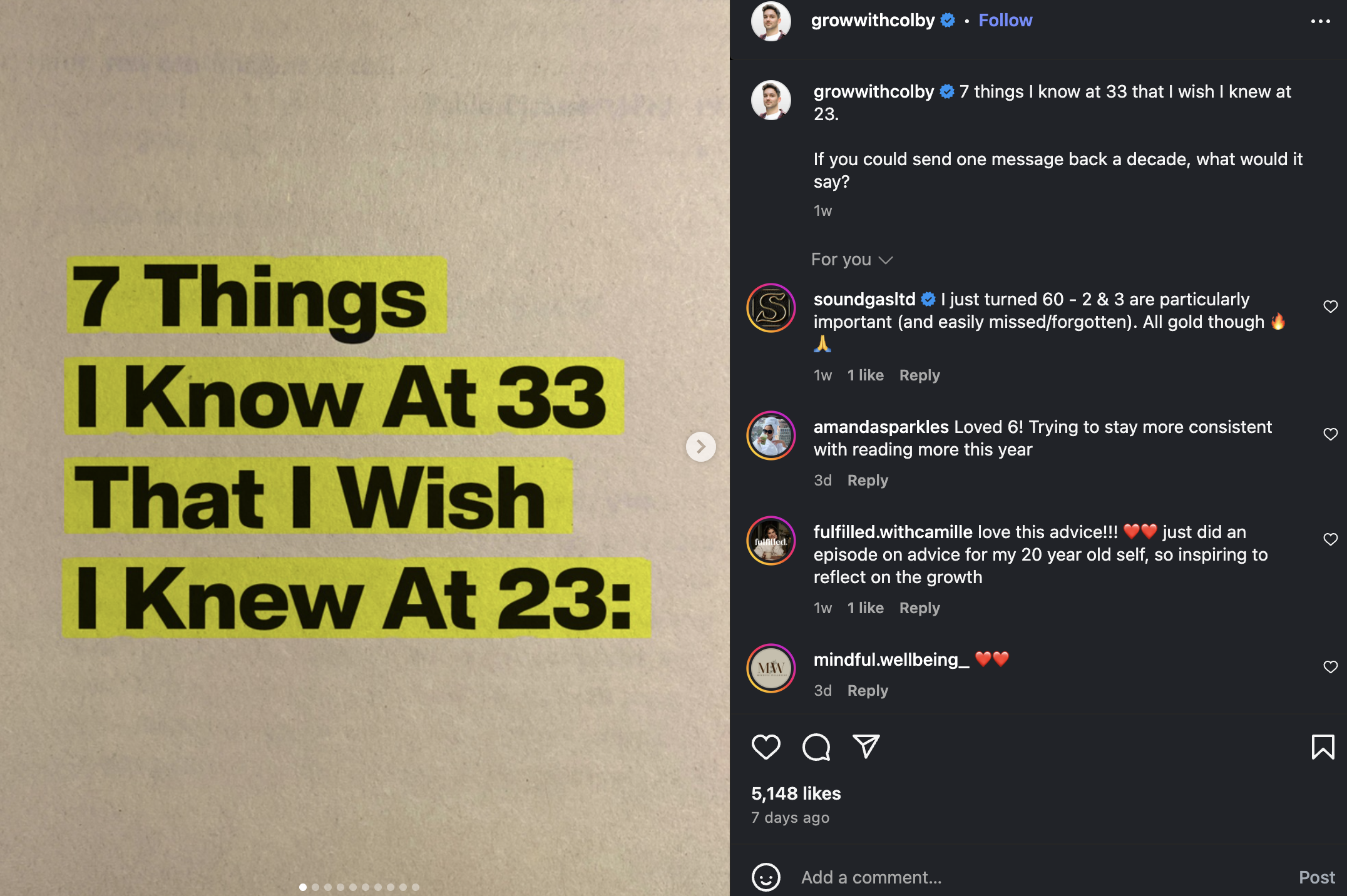
4. Platform-appropriate formatting
Each social media platform has unique user behaviors and content formats. What works on TikTok won’t necessarily work on LinkedIn, and Instagram requires a different approach than Twitter. Understanding these nuances is crucial for creating hooks that feel native to each platform and resonate with their specific audiences.
Real-life platform examples:
@hannagetshired demonstrates perfect Instagram formatting with career-focused content that uses visual text overlays (“ASK THESE INTERVIEW QUESTIONS”) combined with professional captions. Her hook is “Read + save this before your next interview to make sure your role isn’t the first to go when the belt tightens.” Addresses career anxiety while providing actionable value. This approach balances Instagram’s visual-first nature with valuable professional content.
Platform-specific guidelines:
- Instagram: Visual-first hooks work best, with captions that complement striking images
- TikTok: Audio and visual hooks that grab attention in the first 2 seconds
- LinkedIn: Professional, insight-driven hooks that promise business value
- Twitter: Concise, punchy hooks that work within character limits
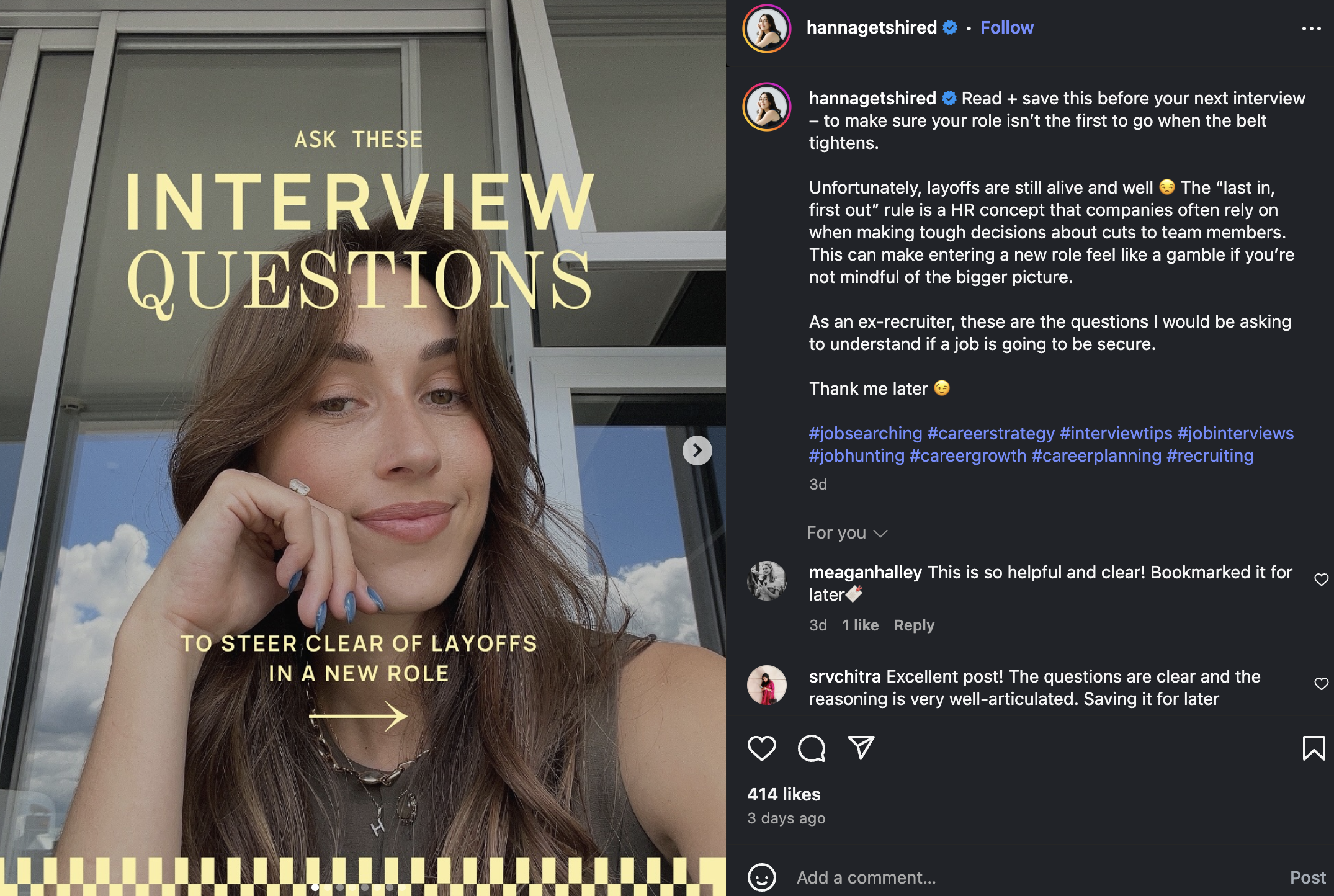
5. Pattern interruption
Hooks that challenge popular beliefs or present contrarian views can capture attention and make content more memorable. Breaking expected patterns makes users pause.
Real-life examples:
@healthymoodsf uses pattern interruption with “Grilled Pesto Chicken Tenders,” breaking the standard expectation that chicken tenders are unhealthy fried food. By combining “grilled” (a healthy cooking method) with “pesto” (a gourmet flavor) and “chicken tenders” (typically junk food), she creates cognitive surprise.
Pattern interrupt examples:
- “Forget everything you know about productivity…”
- “The ‘healthy’ food that’s destroying your gut…”
- “Why I stopped following my own advice…”
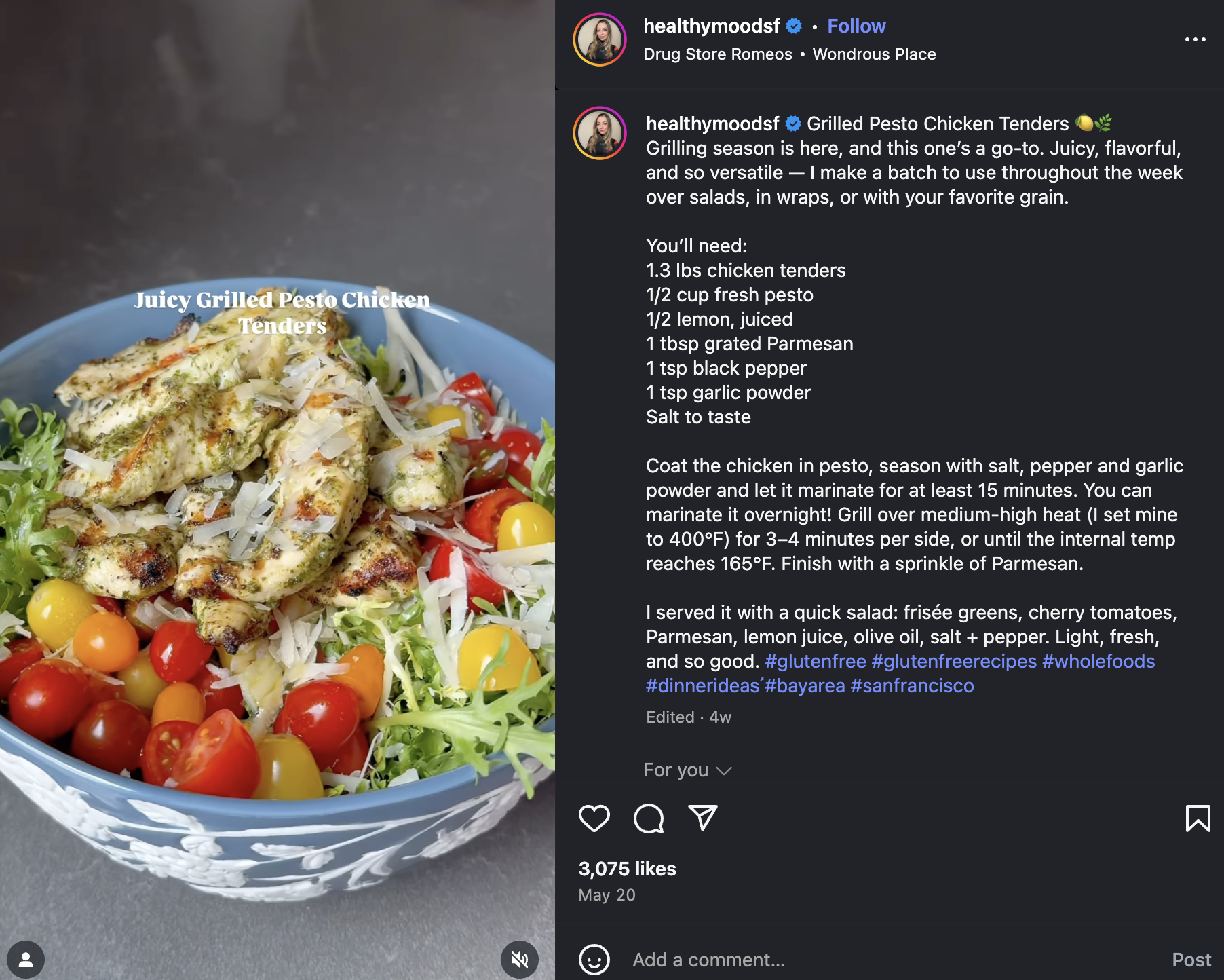
6. Authenticity and Relatability
Modern audiences can spot inauthentic content instantly. The best hooks feel genuine and speak directly to your audience’s experiences. In an era of polished perfection and filtered content, authenticity cuts through the noise by showing vulnerability, admitting mistakes, and sharing real struggles your audience faces daily.
Real-life examples:
Courtney Johnson uses vulnerable hooks, such as “I used to think I had to earn credibility. Now I know I just needed to CLAIM IT.” This authentic admission of past insecurity and personal growth resonates powerfully with entrepreneurs and professionals. Her hook, “Positioning yourself will take you further than perfection ever could,” challenges the perfectionism trap many professionals struggle with, making her content highly relatable and shareable.
Authentic hook formulas:
- “Here’s what nobody tells you about…”
- “I wish someone had told me this before…”
- “The reality behind those perfect Instagram posts…”
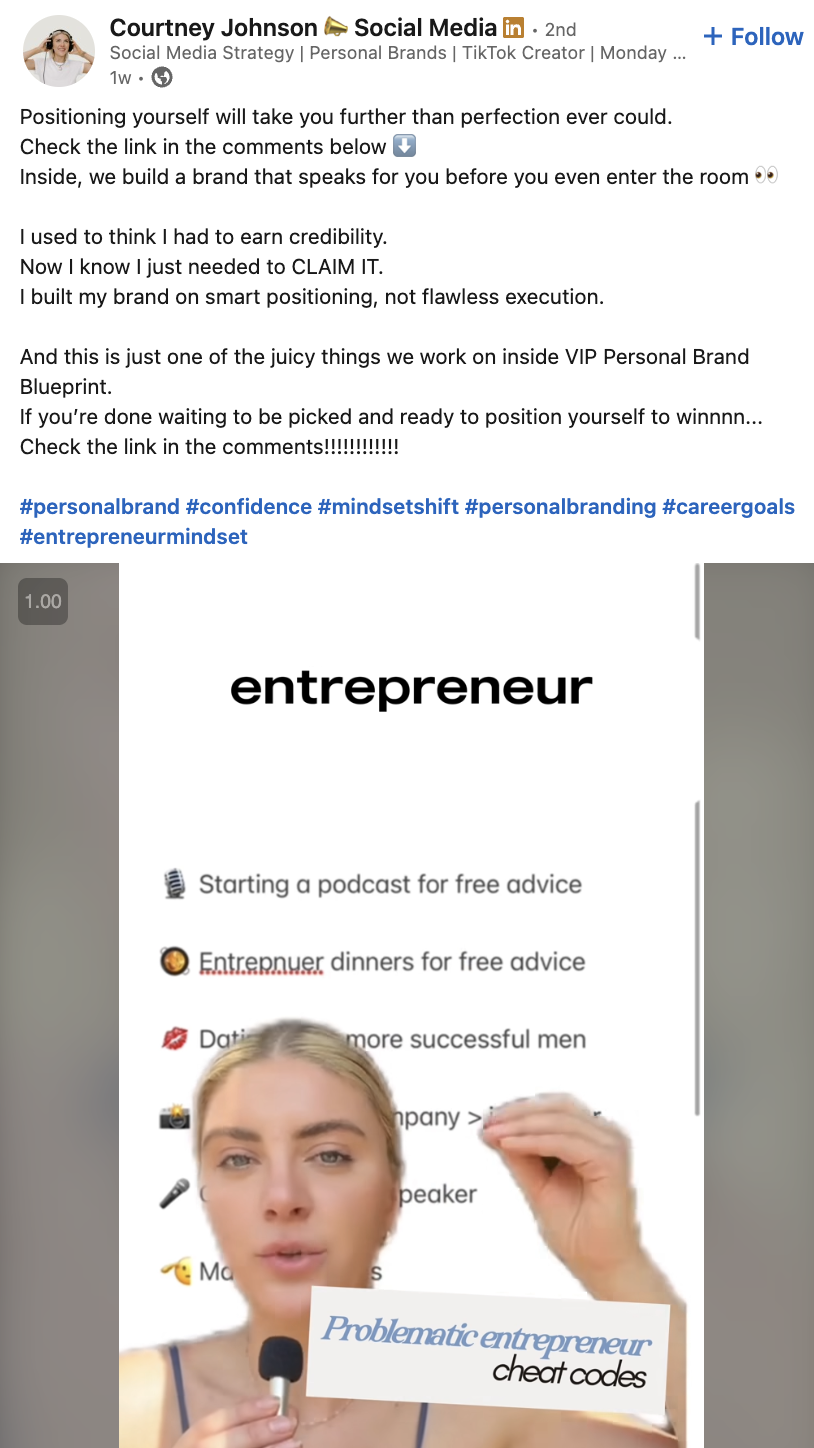
7 proven strategies to create thumb-stopping social media hooks
Crafting social media hooks that stop users in their tracks requires a mix of creativity, strategy, and a deep understanding of your audience. Here are some tried-and-true methods to help you create hooks that capture attention and drive meaningful engagement.
Strategy 1: Lead with surprising data or statistics
Numbers, statistics, or data in your hooks can significantly boost their credibility and appeal. Data-driven hooks instantly establish credibility while creating curiosity about the source.
Data hook examples:
- “87% of marketers are making this fatal mistake…”
- “This 30-second habit increased my productivity by 23%…”
- “Companies using this strategy see 156% more engagement…”
- “The $500M industry secret nobody talks about…”
Pro Tip: Always ensure your statistics are accurate and cite credible sources. False data can damage your reputation permanently.
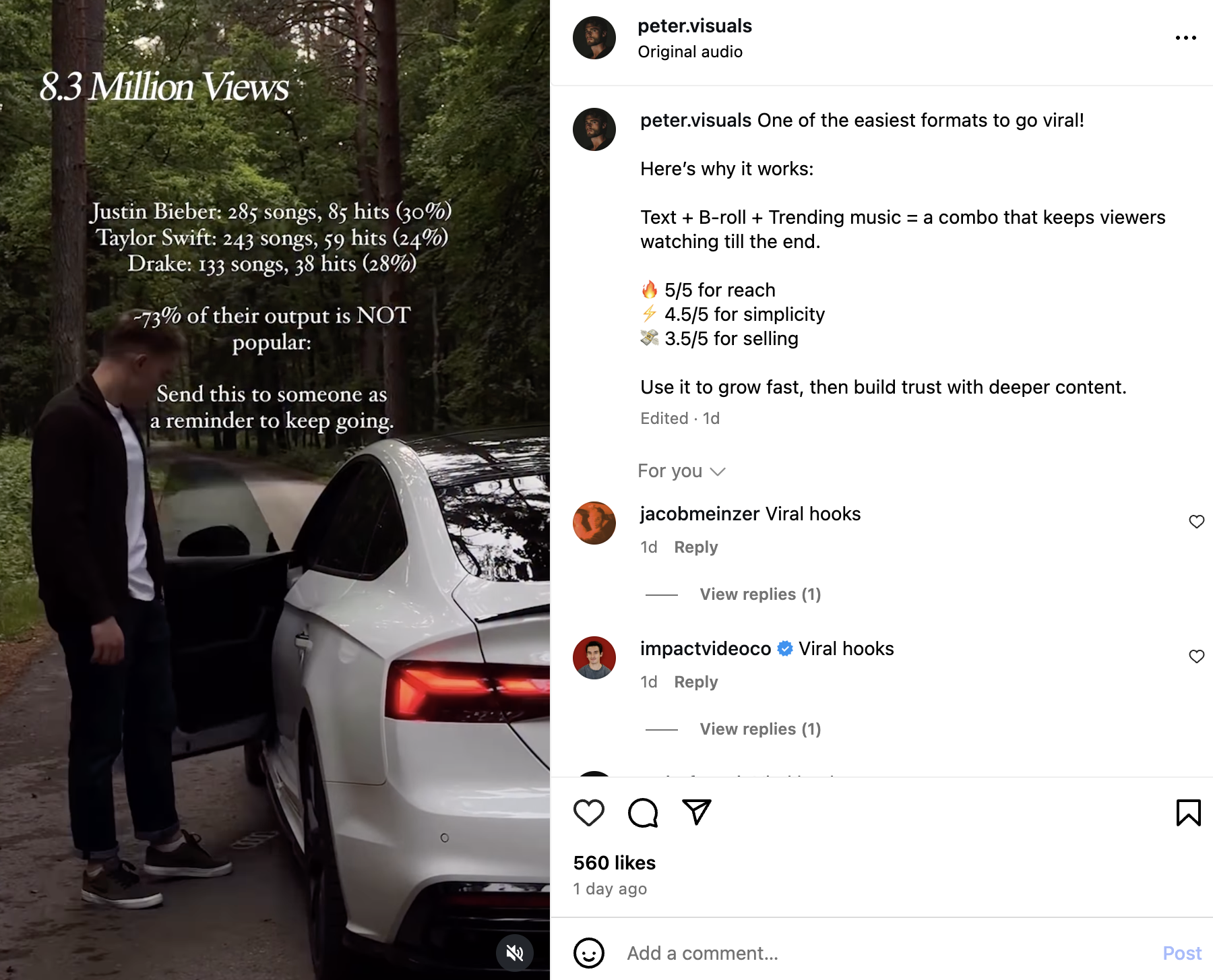
Strategy 2: Create curiosity gaps
Curiosity is a powerful motivator. Leaving a bit of mystery in your hook encourages users to click, read, or watch to satisfy their curiosity. The key is to tease enough information to make them want more without revealing everything upfront.
Curiosity Gap Formulas:
- “The mistake that cost me $10,000…”
- “The weird trick that…”
- “What happened next will shock you…”
- “The secret ingredient nobody expects…”
- “Why [successful person] swears by this method…”
Real-world example: Drunk Elephant expertly aroused curiosity during the launch of their new product, C-Luma, by gradually teasing the product’s benefits over several days with hooks like “Something hydrating coming soon…” followed by “Something brightening coming soon…”
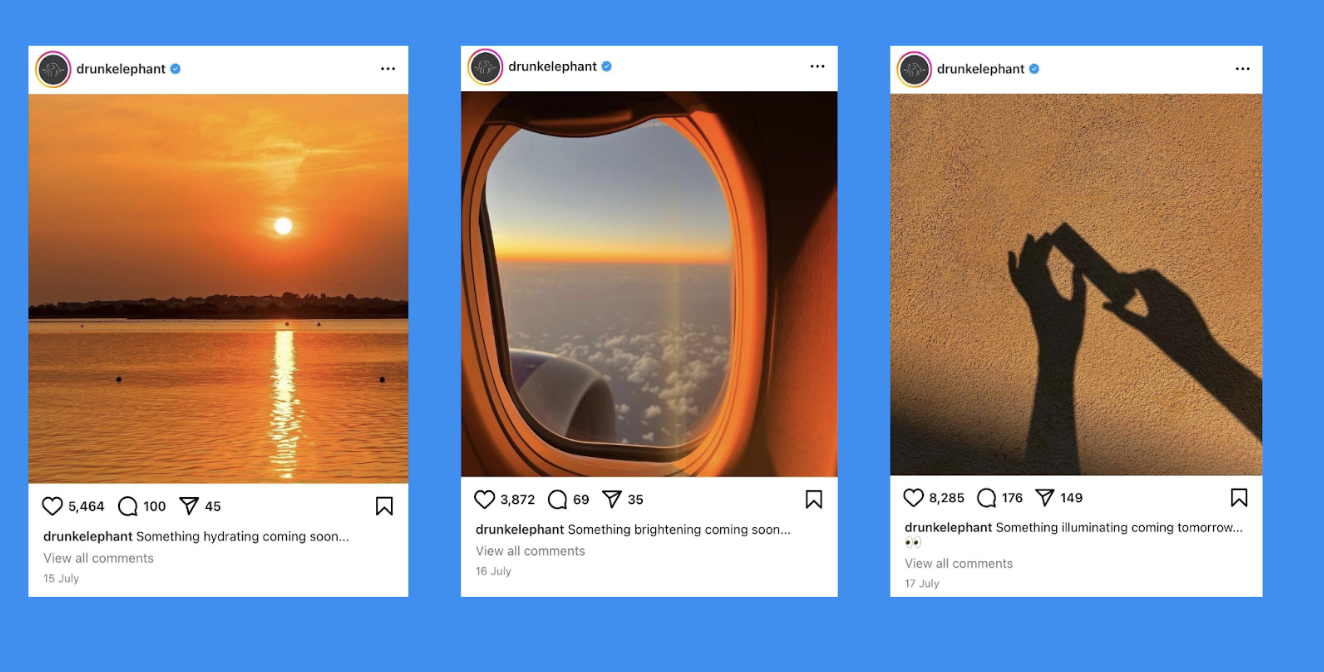
Strategy 3: Use problem-solution hooks
Address a specific pain point your audience faces, then promise a solution. This approach works because it immediately identifies with user frustrations.
Problem-solution hook templates:
- “Tired of [problem]? Here’s how to fix it in [timeframe]…”
- “If you’re struggling with [issue], try this instead…”
- “The real reason your [desired outcome] isn’t working…”
- “How to [achieve goal] without [common obstacle]…”
Examples:
- “Tired of low engagement? Here’s how to double your likes in 30 days…”
- “If you’re struggling with productivity, try this 2-minute rule…”
- “The real reason your content isn’t going viral…”
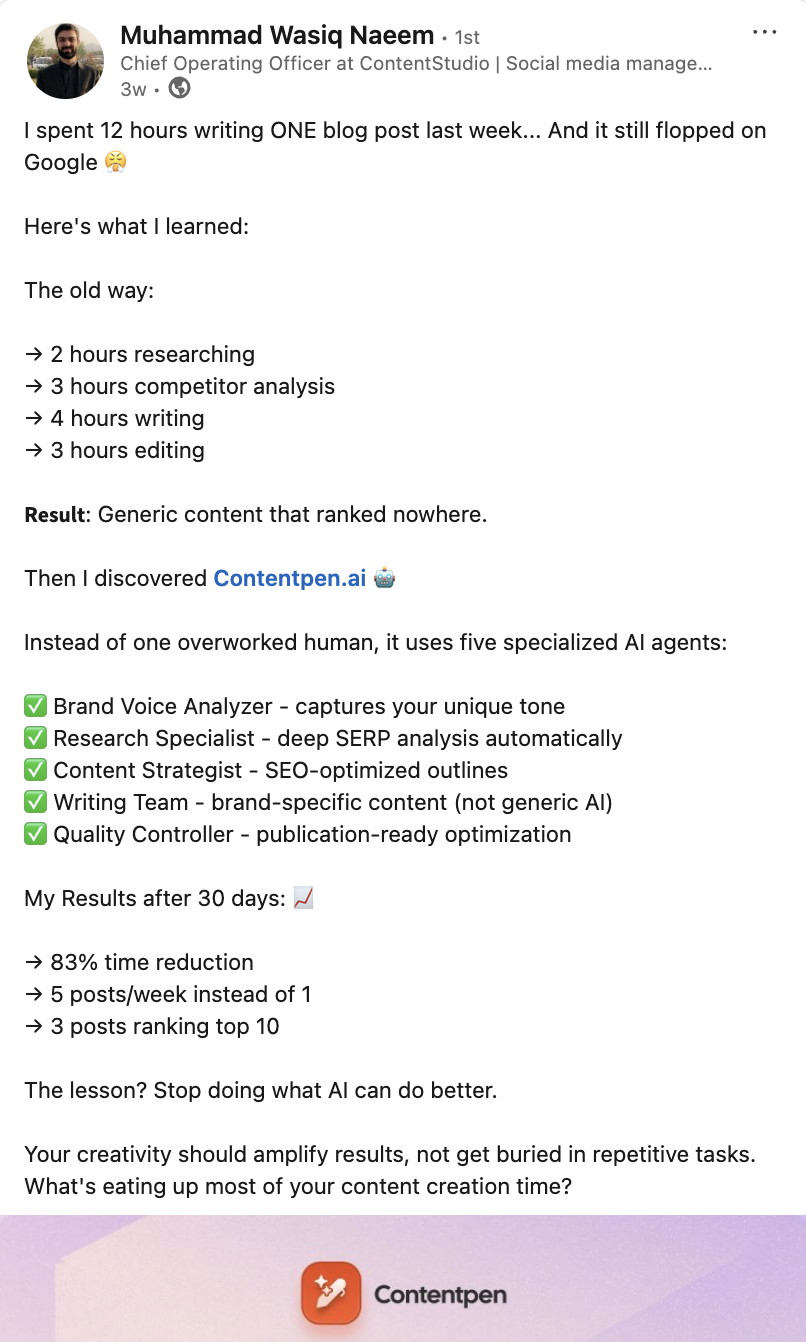
Strategy 4: Leverage social proof and authority
Social proof is when people copy the actions of others like them. Using testimonials, case studies, or expert endorsements in your hooks builds instant credibility.
Social proof hook examples:
- “The strategy 500+ successful entrepreneurs use…”
- “What [industry expert] taught me about [topic]…”
- “How [well-known company] increased revenue by 300%…”
- “The method recommended by [credible source/study]…”
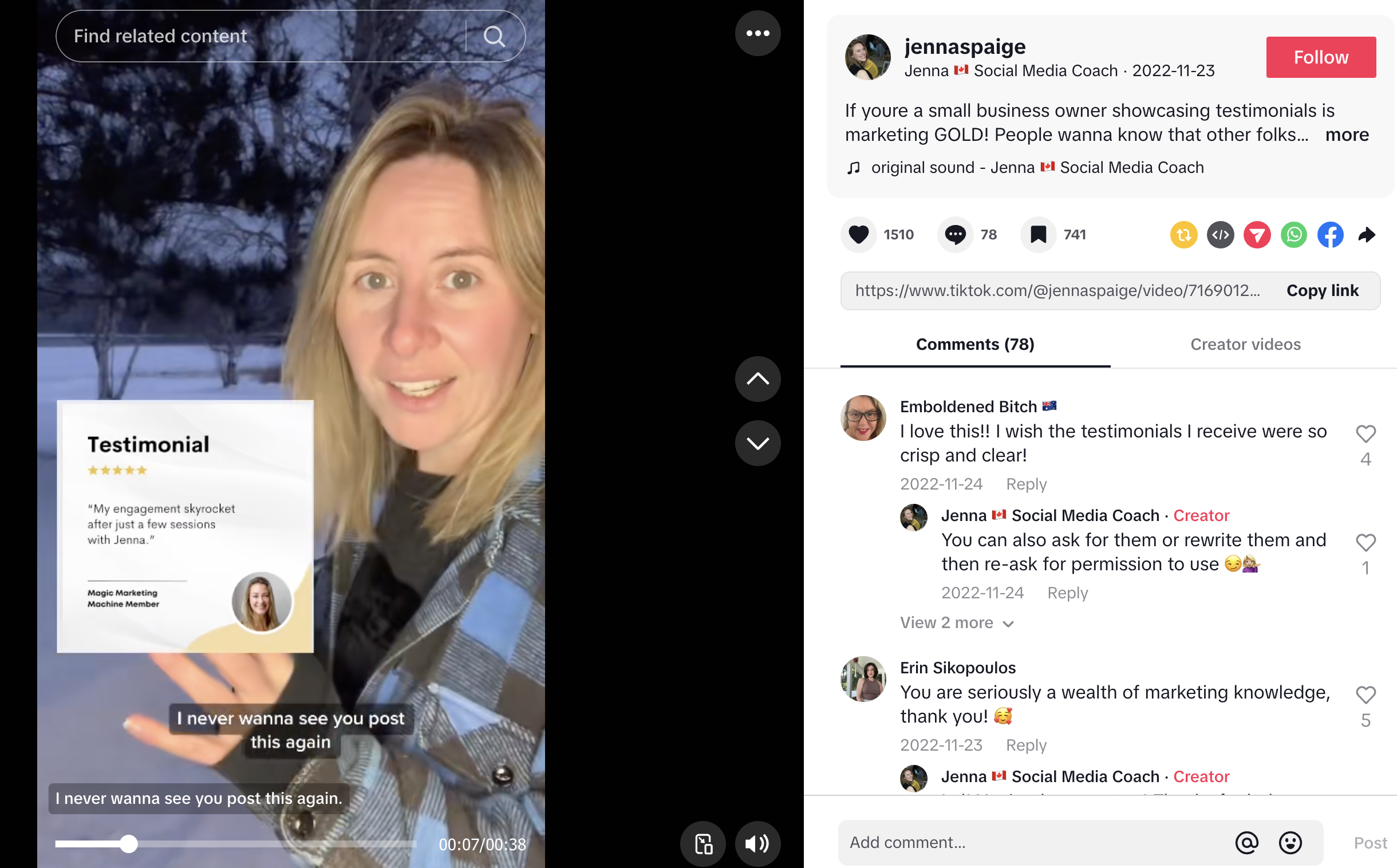
Strategy 5: Make bold or contrarian claims
Contrarian statements challenge popular beliefs and can capture attention by standing out from conventional views. However, ensure you can back up controversial claims with evidence.
Contrarian hook examples:
- “Why following your passion is terrible career advice…”
- “The productivity hack that actually makes you less productive…”
- “Why I stopped using Instagram Stories (and you should too)…”
- “The marketing strategy everyone uses that doesn’t work…”
Example:
Microsoft effectively used superlatives in a LinkedIn post to highlight their partner’s achievements, EWII. By stating that EWII is on a mission to become “the most customer-centric and innovative supply supermarket,” Microsoft emphasizes the company’s ambitious goals and positions their collaboration as a leading example of digital transformation in the industry. This use of superlatives draws attention to the unique value EWII and Immeo bring to the market, encouraging readers to learn more about their groundbreaking work and how it’s setting new industry standards.
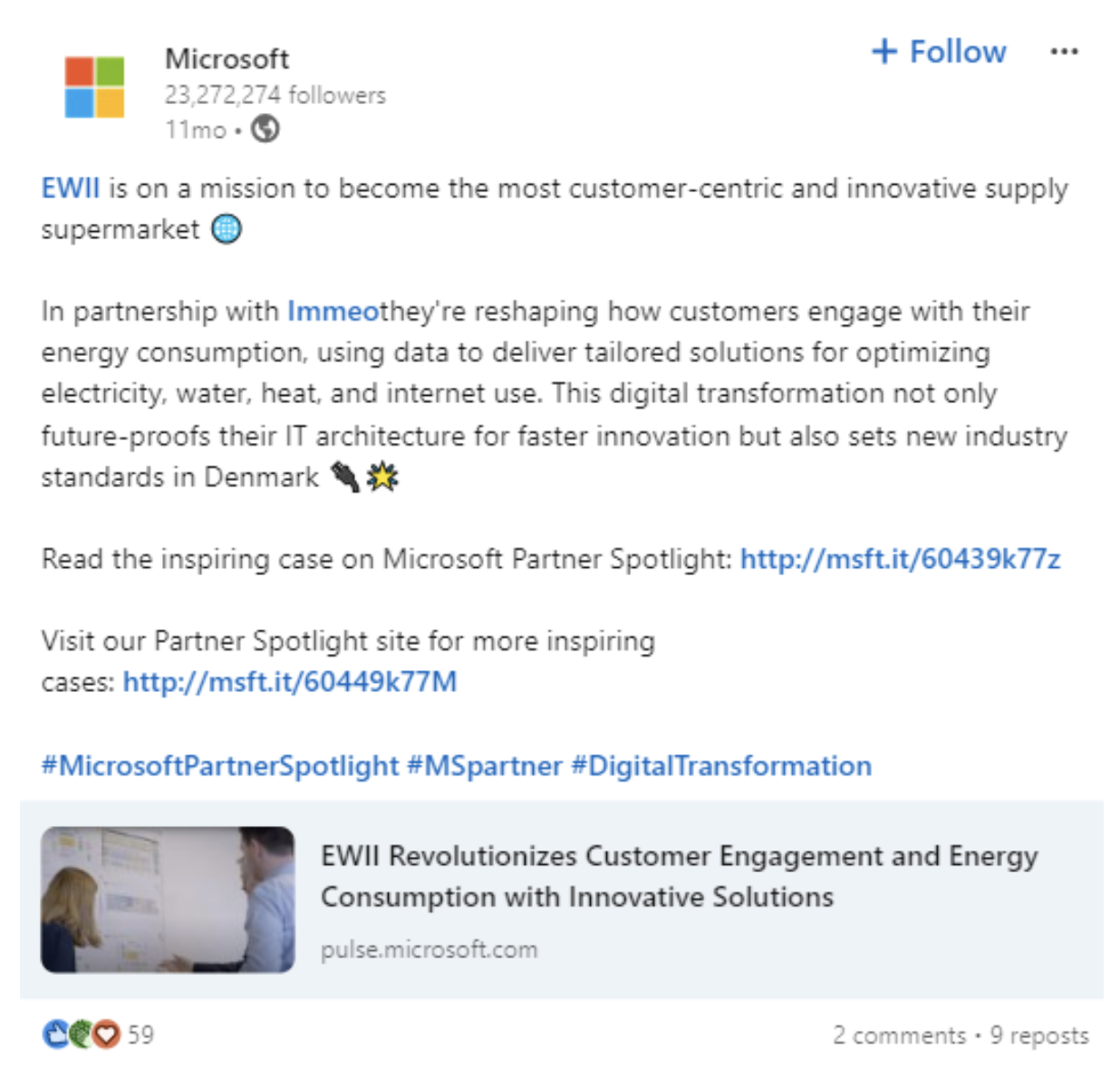
Strategy 6: Use storytelling hooks
Stories create emotional connections and are naturally engaging. Start with a compelling narrative moment that draws readers into your experience.
Story hook formulas:
- “Last week, something happened that changed everything…”
- “The conversation that made me rethink [topic]…”
- “I used to believe [common belief] until…”
- “The day I realized [insight]…”
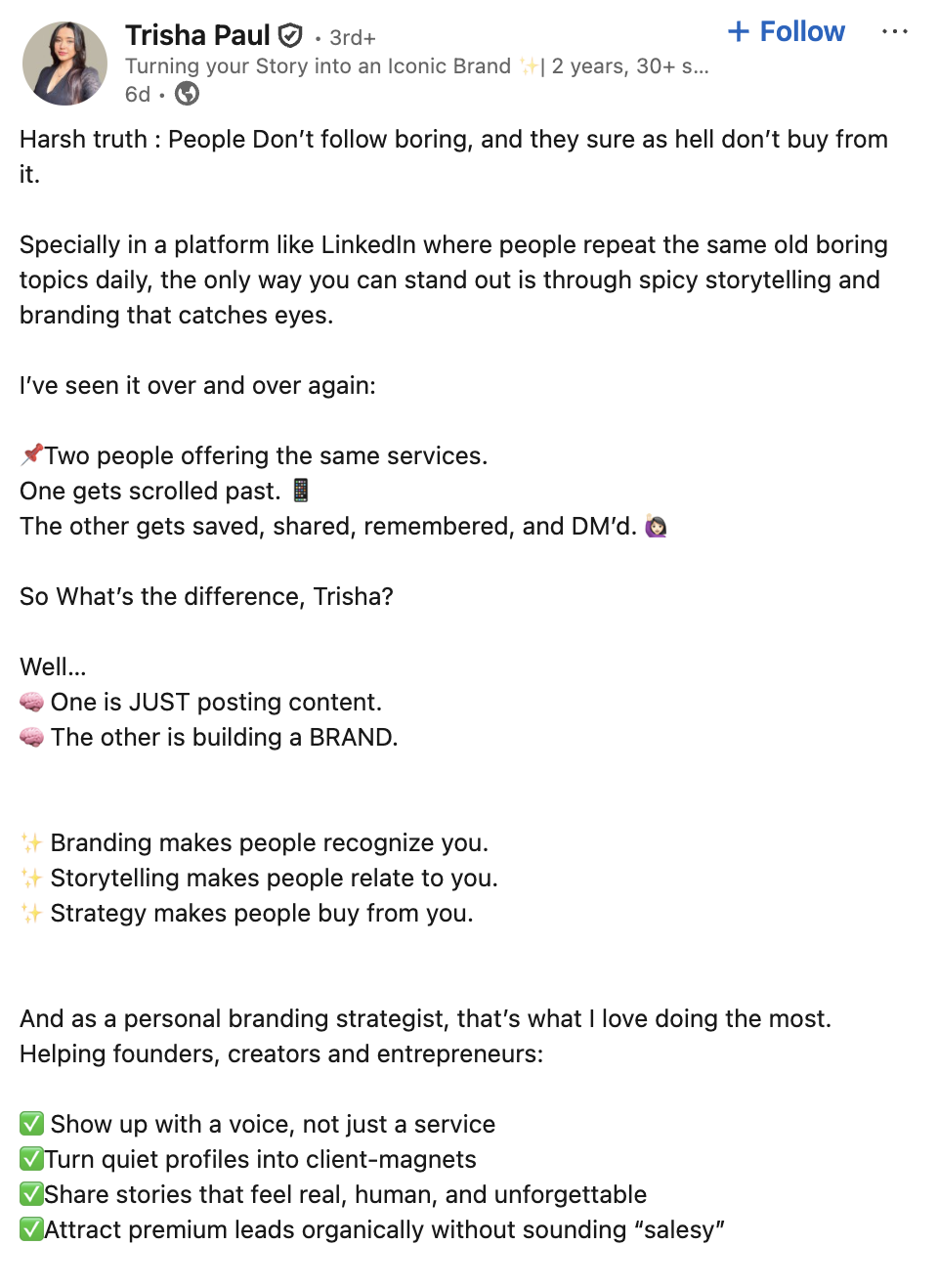
Strategy 7: Ask compelling questions
Questions immediately engage readers by prompting mental responses. The best questions tap into curiosity, self-reflection, or decision-making.
Question hook categories:
- Self-Assessment: “Are you making these 5 common mistakes?”
- Curiosity-Driven: “What if everything you know about [topic] is wrong?”
- Choice-Based: “Would you rather have [option A] or [option B]?”
- Challenge-Based: “Can you spot the problem in this [example]?”
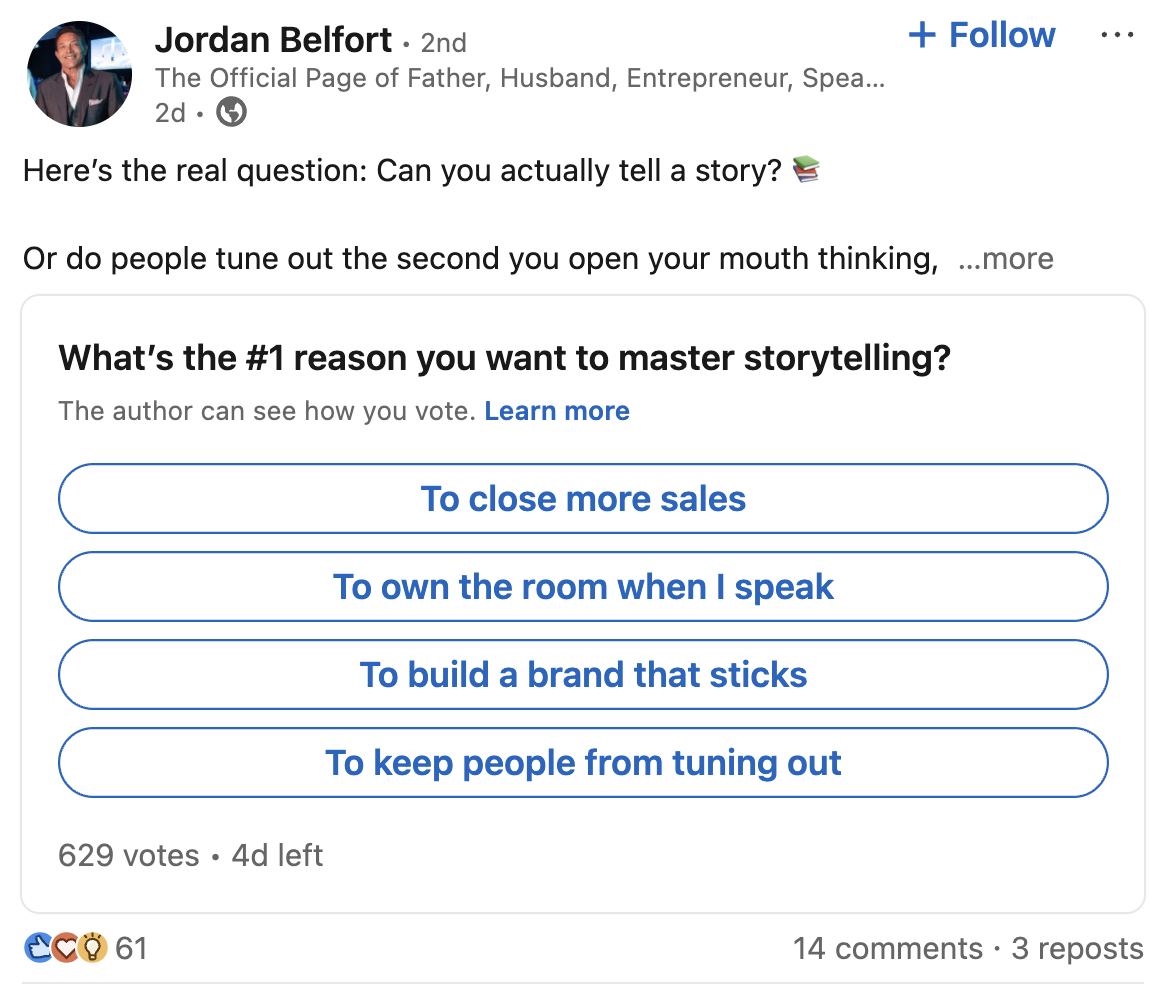
30+ Proven social media hook examples
1.“This may be controversial but…”
Starting with a provocative statement immediately grabs attention. People are drawn to controversy and may want to see what the fuss is about.
Example: “This may be controversial, but pineapple on pizza is a culinary masterpiece.”
2. “___ type of people… stop scrolling!”
This hook creates a sense of exclusivity and challenges the reader to see if they fit the description.
Example: “Introverts, stop scrolling! This tip will change how you network.”
3. “Everything you knew about ___ is 100% WRONG!”
Challenging a common belief or assumption piques curiosity, prompting the audience to learn more.
Example: “Everything you knew about healthy eating is 100% WRONG! Here’s why…”
4. “I just found the perfect product that helps with ___”
This hook promises a solution to a problem, which can be particularly enticing for readers looking for answers.
Example: “I just found the perfect product that helps with dry skin – and it’s under $20!”
5. “Instead of buying this (hold up popular product), I have another recommendation…”
Offering an alternative to a popular product makes readers curious about what could be better.
Example: “Instead of buying the latest iPhone, check out this budget-friendly alternative.”
6. “Here’s a simple hack to help you do ___”
People love life hacks, especially when they’re simple and easy to implement.
Example: “Here’s a simple hack to help you fall asleep faster.”
7. “This (insert niche) hack could save you XX amount of money”
Offering a financial benefit is a great way to attract attention, especially when it’s linked to a specific figure.
Example: “This grocery shopping hack could save you $100 a month.”
8. “If you are into (insert niche) you need to stop doing this…”
This hook introduces a sense of urgency and correction, encouraging readers to rethink their habits.
Example: “If you are into fitness, you need to stop making this common workout mistake.”
9. “I couldn’t believe (insert person)’s reaction to XX…”
Personal stories or reactions, especially from known figures, can create intrigue and engagement.
Example: “I couldn’t believe my coach’s reaction to my new training routine…”
10. “Let’s see if (Insert person) can do XX in (amount of time)…”
Challenges are engaging, especially when they involve a time limit and a well-known person.
Example: “Let’s see if Chef Jamie can make a gourmet meal in under 10 minutes.”
11. “Red flags to look for in (insert niche)…”
Highlighting potential pitfalls or warning signs in a niche captures attention and offers value.
Example: “Red flags to look for in online job listings…”
12. “Life Hack: Try [product] for [pain point]…”
Combining a life hack with a solution to a common pain point is a winning formula.
Example: “Life Hack: Try this tea for a better night’s sleep.”
13. “Something that’s always bothered me about X…”
Personal grievances are relatable and can resonate with others who feel the same way.
Example: “Something that’s always bothered me about skincare routines…”
14. “I kept getting [pain point], so I tried this instead!”
Sharing a problem and how you solved it is a powerful way to connect with your audience.
Example: “I kept getting headaches, so I tried this hydration technique instead!”
15. “This [product type] has over 5,000 reviews… let’s see if it’s worth it.”
Reviewing a popular product with a lot of buzz draws in readers who are curious about its effectiveness.
Example: “This air fryer has over 5,000 reviews… let’s see if it’s worth the hype.”
16. “You need this (insert product) if you want to save time and effort…”
Offering a solution that promises to save time and effort is always appealing.
Example: “You need this meal prep kit if you want to save time in the kitchen.”
17. “4 things you’re NOT doing to improve XX…”
Presenting missed opportunities is a great way to capture attention and encourage action.
Example: “4 things you’re NOT doing to improve your mental health.”
18. “Get more [value prop] in your day by doing this one thing…”
This hook promises a simple solution to enhance daily life, which is enticing for readers.
Example: “Get more energy in your day by doing this one morning habit.”
19. “If you’re like me and do X, then this one is for you.”
Relatable hooks foster connection and make the audience feel seen and understood.
Example: “If you’re like me and hate mornings, then this one is for you.”
20. “This video is only for X people, so keep scrolling if that’s not you.”
Creating exclusivity can make readers more eager to see if they qualify.
Example: “This video is only for coffee lovers, so keep scrolling if that’s not you.”
21. “This free tool changed the game for me…”
Offering something valuable for free is a strong incentive for engagement.
Example: “This free budgeting app changed the game for me…”
22. “Here are 2 signs that you should stop doing XX”
Identifying behaviors to avoid adds value by helping the audience course-correct.
Example: “Here are 2 signs you should stop procrastinating at work.”
23. “Here are 2 signs you should start doing XX”
Conversely, pointing out positive actions to start is equally engaging.
Example: “Here are 2 signs you should start saving more for retirement.”
24. “I tried the top (insert niche) products so you don’t have to…”
Reviewing products in a niche saves your audience time and effort, adding immense value.
Example: “I tried the top skincare products so you don’t have to – here’s what I found.”
25. “This is why your ___ isn’t working…”
Offering an explanation for why something isn’t working addresses frustration and provides a solution.
Example: “This is why your diet isn’t working – and how to fix it.”
26. “Before you do XX like always… check out XX”
Encouraging the audience to try something different before falling into old habits is a great way to pique interest.
Example: “Before you buy your usual shampoo, check out this sulfate-free option.”
27. “If you’re feeling skeptical about XX… try this…”
Acknowledging skepticism and offering an alternative can be disarming and persuasive.
Example: “If you’re feeling skeptical about meditation, try this simple breathing exercise.”
28. “This is for the (type of person) XX looking for (result)”
Targeting a specific group with a promise of results makes your content feel personalized.
Example: “This is for the busy professional looking to stay fit – here’s how.”
29. “Why is nobody talking about XX in the XX industry?”
Pointing out overlooked topics can position you as a thought leader and spark discussion.
Example: “Why is nobody discussing mental health in the tech industry?”
30. “This is the only thing you need to know about ___!”
Simplifying complex topics into one key takeaway can be very appealing.
Example: “This is the only thing you need to know about boosting your metabolism.”
31. “This is the mistake every (insert niche) business owner makes…”
Highlighting common mistakes creates a sense of urgency to avoid them.
Example: “This is the mistake every small business owner makes – and how to avoid it.”
32. “I tried every affordable XX brand out there and here are the results…”
Testing multiple options and sharing the results saves your audience time and adds value.
Example: “I tried every affordable coffee maker out there – here’s which one is worth your money.”
33. “This is the lazy way to get (insert result)…”
Everyone loves an easy solution, and framing it as “lazy” adds a touch of humor.
Example: “This is the lazy way to get in shape without leaving your couch.”
34. “I spent an entire week trying XX… here’s what I discovered…”
Dedicating time to an experiment and sharing your findings provides authentic insights.
Example: “I spent an entire week trying intermittent fasting – here’s what I discovered.”
Get your audience to pay attention!
Crafting effective social media hooks is essential for capturing attention and driving engagement. By focusing on value, arousing curiosity, leveraging data, and using captivating visuals, you can ensure your posts stand out and resonate with your audience.
As attention spans shrink, mastering these strategies becomes even more critical. Social media tactics will likely change substantially throughout the coming years, so staying adaptable and experimenting with new approaches is important. Tailor your hooks to your audience and platform, monitor their effectiveness, and refine your strategy for maximum impact.
Plan, schedule, share, and analyze content for 15+ social media channels.
Try ContentStudio for FREE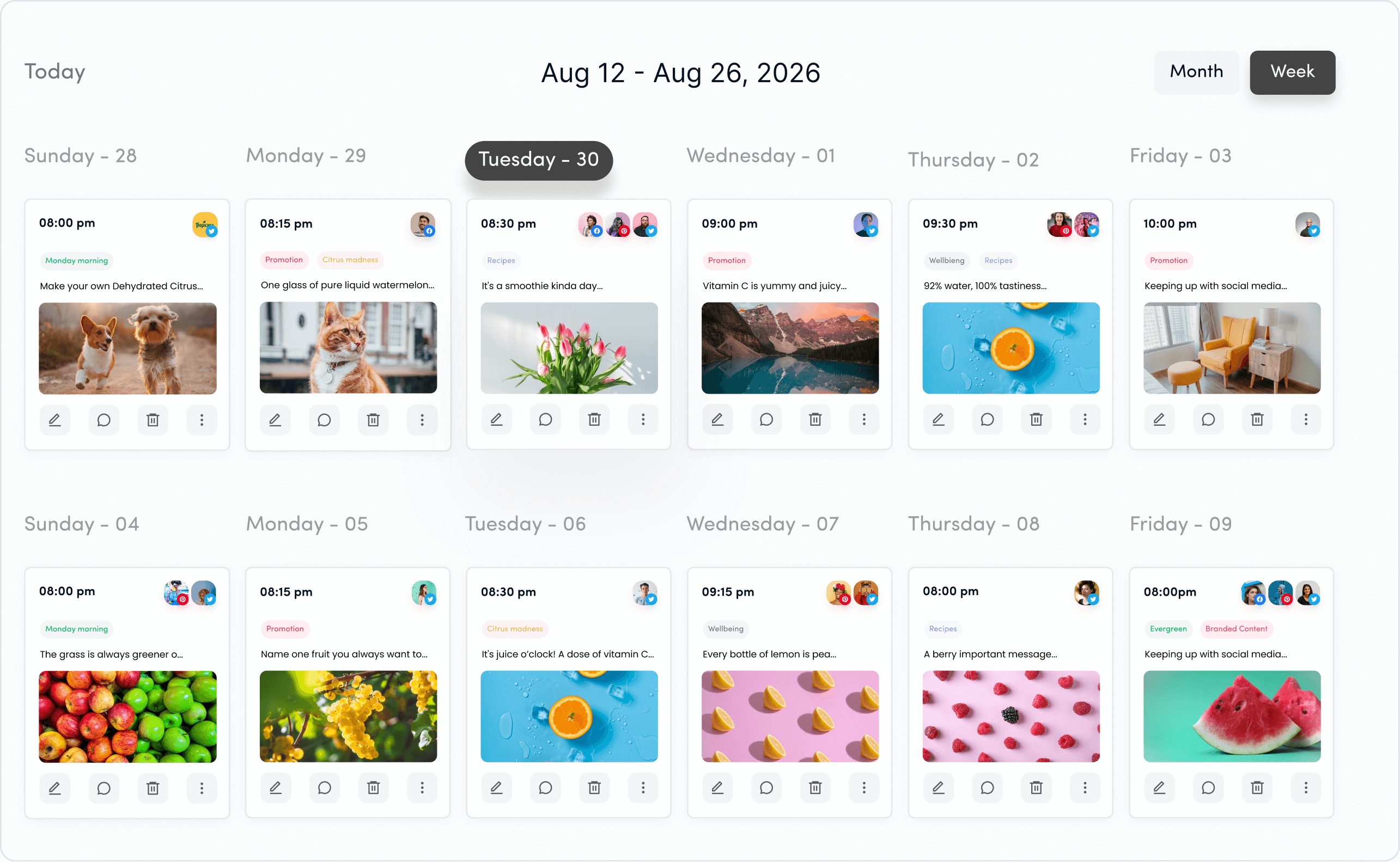
FAQ’s
How do you write a hook about social media?
To write an effective social media hook, start with a compelling opening that promises immediate value, use specific numbers or data, tap into emotions like curiosity or urgency, and match your platform’s tone. The best hooks combine clear value with psychological triggers that make users want to engage.
What is an example of a content hook?
A powerful content hook example is, “The $15 skincare product that outperformed luxury brands in blind testing—here’s the proof.” This works because it includes a specific price, makes a bold claim, adds credibility, and promises evidence.
What makes a social media hook effective in 2025?
Effective 2025 hooks combine authenticity with strategic psychology. They grab attention within 1-2 seconds, provide clear value, use platform-appropriate formatting, and create genuine curiosity without misleading clickbait. Success comes from adapting to trends while maintaining your brand voice.
Recommended for you
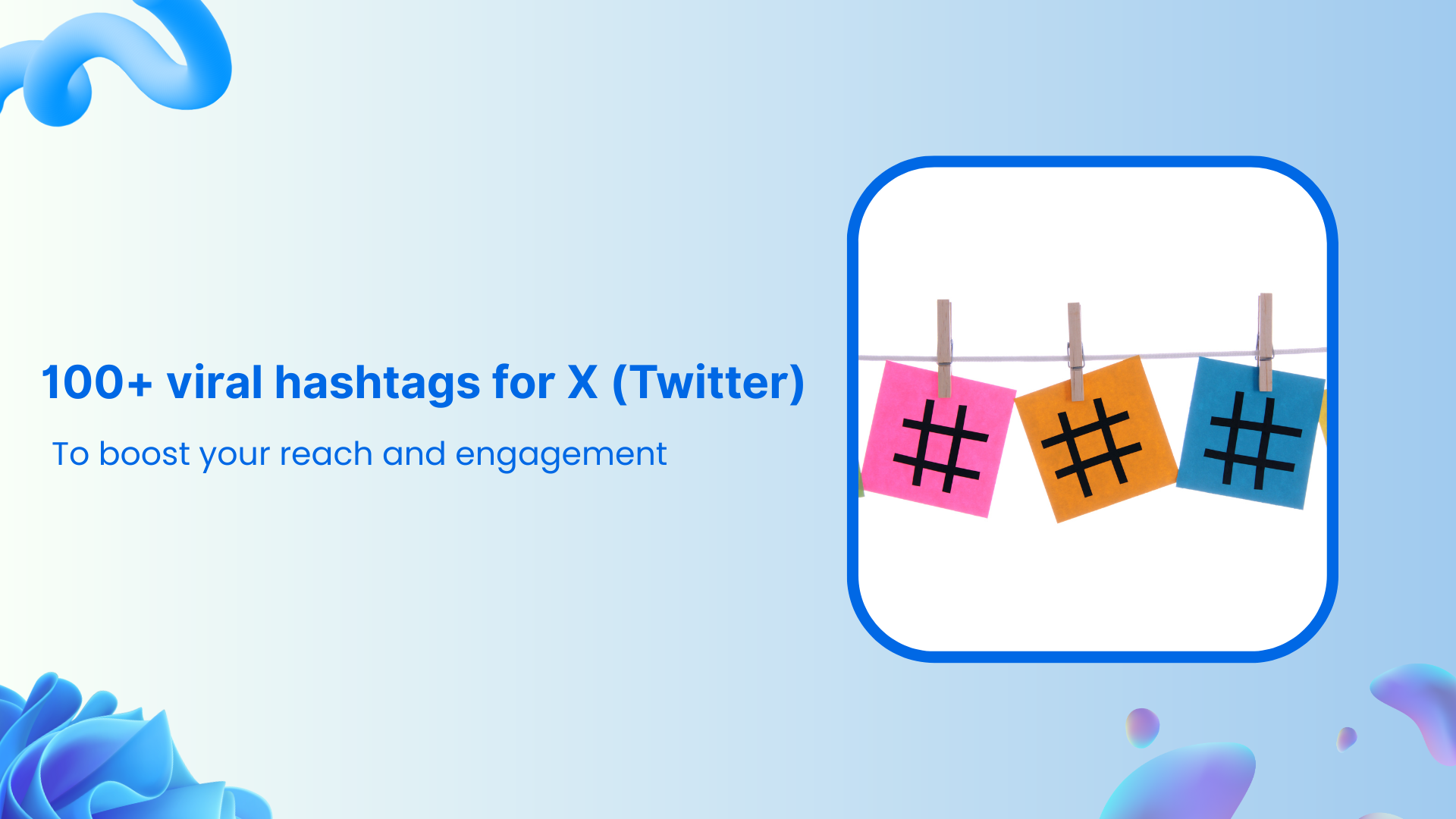
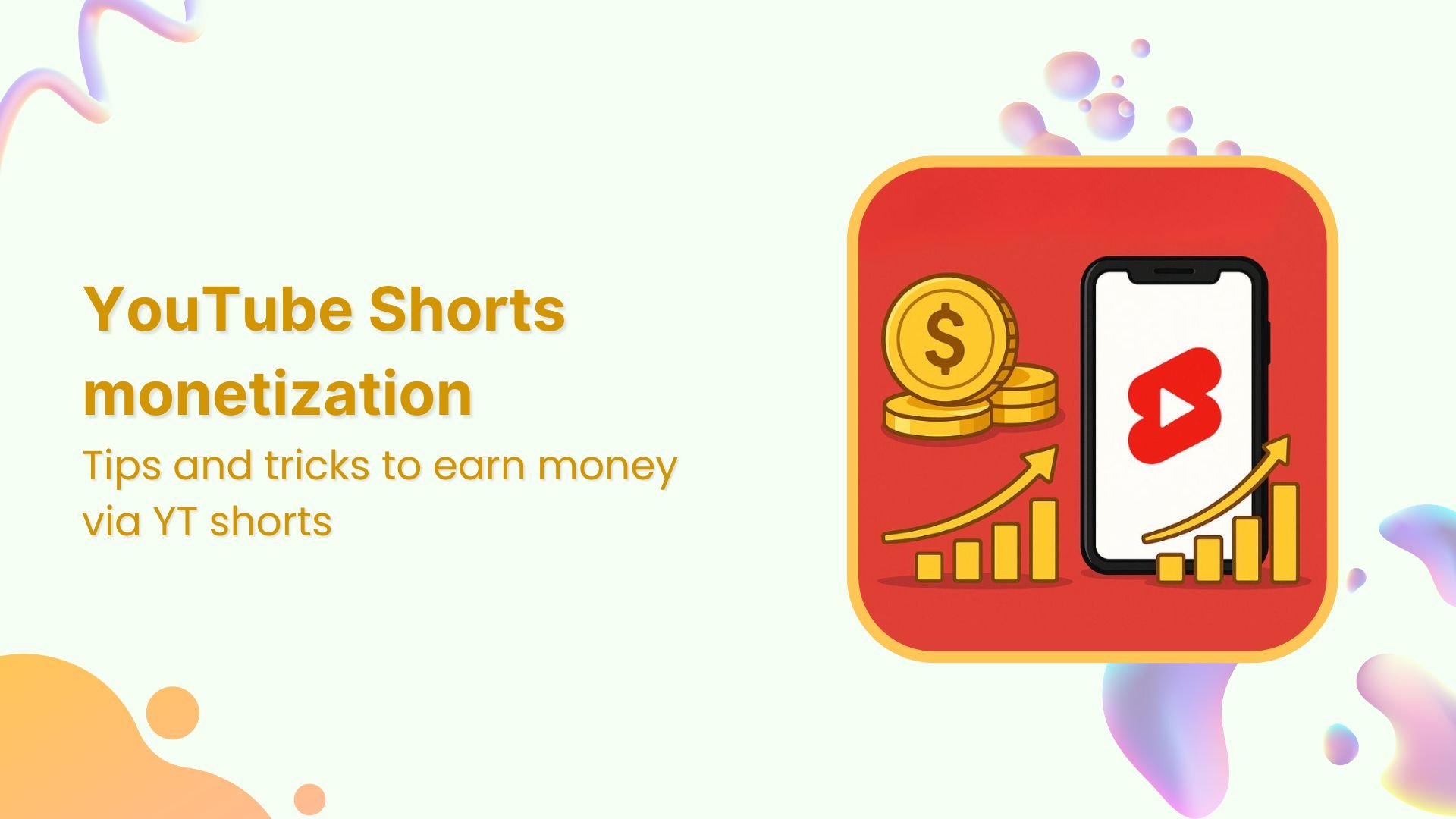
![Social media questionnaire for onboarding new clients [30+ questions]](https://internal-blog.contentstudio.io/wp-content/uploads/2025/08/Social-media-questionnaire.jpg)
